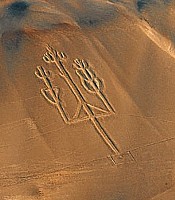http://www.dailykos.com/story/2013/04/2 ... Hypothesis
....But the idea of PIE itself still remains mostly a metaphoric prop. It is more a way to try to make sense of something that so far remains firmly in the 'unknowable' column (although it sees plenty of action in the 'theorizable' column) than an actual unified language that was actually spoken by actual people at some actual point in time.
As a language variationist by training, meaning as someone who conceptualizes variation and change as constant and defining features of living languages, I sometimes find it hard to justify (to myself, even) some of the compromises I have to make in order to teach concepts that can otherwise be difficult for students (and for me) to get their heads around. I do try to be up front about it, though, and explain to the students that I am asking them to join me in suspending our disbelief, that I think it's important for us to be conscious that we are in fact having to suspend disbelief and also for us to talk about why we have to, and that I haven't yet been able to figure out a way for us not to have to.
When we talk about PIE, we are going for convenience, for the short version, using a word (PIE) or a phrase (Proto-Indo-European) that refers not to a single, discrete language (if there even is such a thing) but to a multitude of meanings -- overlapping, complementary, contradictory -- to save us the time and trouble of stopping and pondering what all is contained within that word or phrase because if we did stop to ponder it, there's a good chance that we would never have time for anything else.
So PIE is a relief, a tool, a technological development that saves us the trouble of risking a time-consuming mind-blow every time we need to refer to what were probably a lot of different ways of speaking that varied across space, probably to the tune of thousands of miles, and over time, possibly even thousands of years, but that still are somehow, at least metaphorically, one. And not just any one, but for us the one: Proto-Indo-European, the one that gave rise to so many other ones: Greek, Bengali, Portuguese, Czech, Kurdish, Icelandic, Hindi, Spanish, Russian, Armenian, Yiddish, Latin, Afrikaans, Welsh, Catalan, Pashto, French, and English, to name a few. Some of them are still living and some are lost to the past, but even many of those lost languages have traces remaining somewhere in the approximately 440 Indo-European languages spoken in the 21st century by literally half the population of the planet Earth.
I think about this metaphor and ask the students to think about it (and about others we use in class) as a kind of "rounding off," roughly analogous to the way that we can do quick mathematical calculations of large numbers by rounding them off, trading off precision for speed and getting somewhere that probably isn't anywhere near close enough but we pretend it is because we have no choice. One metaphor explains another.
But there had to have been variation during the millenia that PIE is hypothesized to have been extant because there is always variation. Even in a classroom with 30 people in it, of whom 25 have lived their whole lives so far within a few hundred miles of one another, there is always significant variation. The students usually don't notice that much of it at first; like all speakers of all languages, they have spent their whole lives becoming proficient at instantaneously distinguishing between differences they need to pay attention to and the ones they can ignore. But in only a few short months, most of them become very, very good at noticing and describing even relatively slight differences among speakers.
On the other hand, the variation within what we conceptualize as 'PIE' was probably over time and across locations so great as to have meant mutual unintelligibility among its (possibly imaginary) speakers. So in essence, in teaching the Indo-European hypothesis, I am asking the students to imagine and accept as a kind of reality an idealized version of a language that nobody ever really spoke, to make a deal with me to treat the abstract as absolute, even though we know it isn't. Not even close. And yet.







